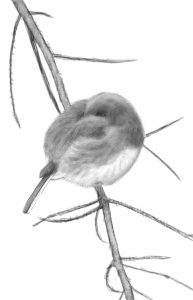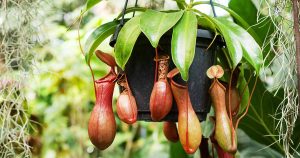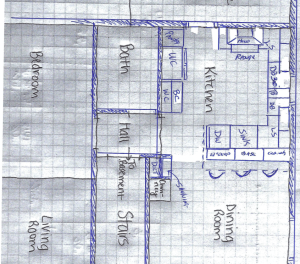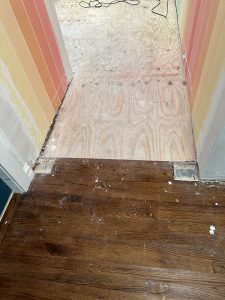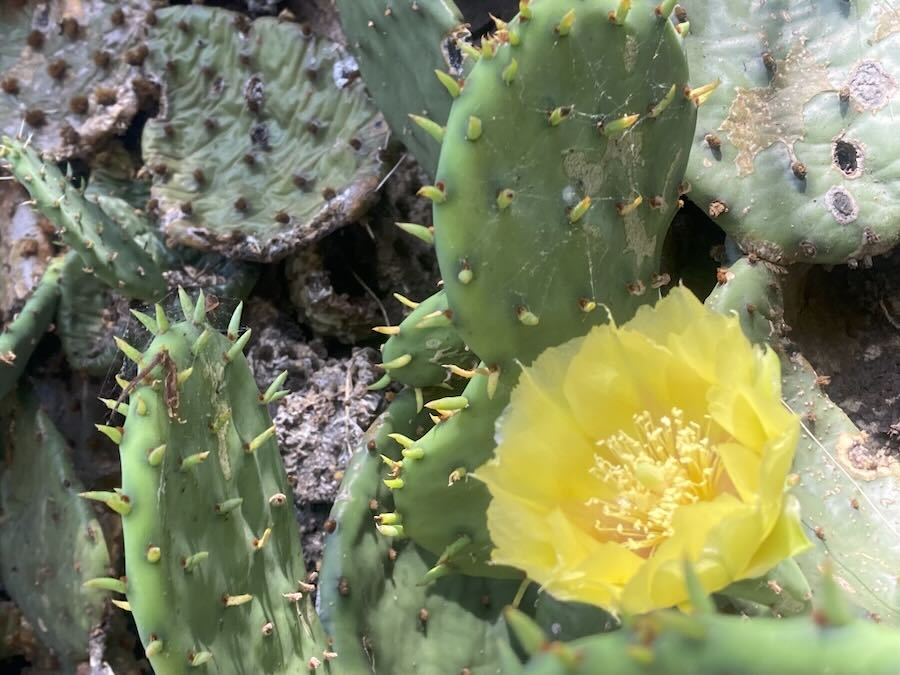
‘PLANTS TELL the story of a place,” says field botanist and native plant nursery owner Jared Rosenbaum. “If you want to be rooted on the earth you live on, you can look to plants to interpret that story.”
With his friend, a filmmaker named Jared Flesher, aka “the other Jared,” Jared Rosenbaum creates what they call funky but highly cinematic five-minute videos about the ecology of wild plants. The second season of their series, titled “Rooted,” is debuting on YouTube at 8 Eastern AM on Sept. 15, with a video on none other than the Eastern prickly pear cactus, the only hardy cactus of the region. Jared the botanist told me about it, and about some other native plant stories.
Jared and his wife, Rachel Mackow, provide design inspiration and plants to clients to make their landscape ideas come true at Wild Ridge Plants, their nursery in rural New Jersey, which is also a mail-order source of distinctive natives. Jared is the author of the book “Wild Plant Culture: A Guide to Restoring Edible and Medicinal Native Plant Communities” (affiliate link).
Plus: Comment in the box near the bottom of this page to enter to win a copy of his book.
Read along as you listen to the Sept. 16, 2024 edition of my public-radio show and podcast using the player below. You can subscribe to all future editions on Apple Podcasts (iTunes) or Spotify (and browse my archive of podcasts here).
 native plant stories, with jared rosenbaum
native plant stories, with jared rosenbaum
Margaret Roach: I haven’t talked to you in a while, and it’s nice to hear your voice. How are you?
Jared Rosenbaum: Thanks so much, Margaret. I’m well. How are you doing?
Margaret: Yeah, I’m good. I guess the last time we talked was probably about “Wild Plant Culture,” and about foraging, and all kinds of other topics. All good, praying for rain [laughter]. You’ve probably had lots of rain. I’ve had none.
Jared: We got a decent rain a couple of days ago, but it has been intermittently really droughty all year long.
Margaret: I always get a weather report from people around the country that I speak to at the beginning of the show.
I was glad to get the word from you of more videos of a second season of “Rooted,” of your series that you do. I enjoyed the first four. I loved your collaboration with the other Jared, because in each video, you tell us about some of the many mysteries, really, of each the native plants you profile.
Mysteries, I use that word because, as you point out in a number of them, it’s not like we know for sure everything. I remember the one in season one about wild ginger, and maybe you can just quickly tell us that little anecdote, because after the glaciers pushed all the plants back down to the Carolinas or whatever, how did wild ginger, which is only able to move a meter or whatever at a time, how did it get all the way back up into the Northeast again in 16,000 years, since the glaciers…these mysteries? It’s so fantastic. I love that you explore them in these beautiful videos, by the way.
Jared: Thank you. We are looking at one wild plant species and using it as a way to talk about an entire habitat, and often, an entire habitat through time. With the wild ginger episode, we’re looking at this little bit of exposed marble geology, in an area of otherwise very different bedrock geology, at a park in New Jersey. Just on this little seam of marble that used to be a quarry, there’s a whole wall of wild ginger [above video and photo below], a little native herbaceous groundcover. I did botanical surveys at that park, it’s over 2,000 acres, wild ginger wasn’t found anywhere else but on this little seam of marble. So the question that I ask myself when I see something like that is, how did this plant find this spot? What is the probability that, in a sea of acidic gneiss and granite bedrock, that somehow, wild ginger would get to this little sliver of marble?
The additional weirdnesses are, wild ginger is dispersed by ants. It’s not like birds are flying it all over the place and pooping it out, and then it has a chance to scatter across the landscape prolifically. It’s dispersed maybe a meter or two a year. In the midst of thousands of acres of potentially geologically inhospitable habitat, because wild ginger likes calcium-rich bedrock, how did it find this space? But then, there’s this deeper-time story too, which is that all of our native plants from northern Jersey on north were pushed down to refugia pretty far south of here during the last ice age, which geologically, it wasn’t really that long ago. How does something get back up that many hundreds, thousands of miles in 10,000 years or so if it’s dispersed a meter per year? We’re weaving these stories, both about the habitat as it is now, but also trying to access, like you said, I really like your wording, the mystery of this. Trying to piece together clues, and ultimately, we don’t really know the answer.
In the latest episode, or the upcoming episode of “Rooted,” we talk about prickly pear cactus. Prickly pear cactus, Opuntia humifusa, is the only cactus that ranges this far up into the Northeast. Cacti are an almost entirely American group of plants, and the genus Opuntia is totally American, and was thought to originate in South America and then radiate up maybe through the Southwest and then over into the Southeast, and then eventually figure out how to adapt to our conditions up here in the northeast. That’s taking place over thousands, hundreds of thousands of years.
Meanwhile, I live in New Jersey. It’s kind of rural-ish, but it’s New Jersey, let’s face it. It’s a lot of forests and post-agricultural land, but there’s this really cool spot, it’s only about 10 minutes south of where I live, and it’s a canyon in the Delaware River. It’s where the river has undercut through all this shale and conglomerate and created cliffs on both sides. On the New Jersey side, the aspect of those cliffs is really southerly, southwestern. It gets a ton of sun, and it’s really hot. It’s kind of the closest thing around here to going to Arizona. [Laughter.] It’s draping down those cliffs, and on the lips and ledges of it is this prickly pear cactus that has somehow made this millennia-long journey and evolutionary journey from South America up to here, but also, somehow made this journey to find these cliffs that are the closest thing we have to Arizona in northern central New Jersey.
On the one hand, I’m telling a story about prickly pear cactus as I see it. It has these beautiful, super-showy flowers. It’s a sprawling cactus that drapes down the ledges of the cliff. It has these specific adaptations to really arid, harsh habitats. Cacti have photosynthetic stems that function like leaves, and it doesn’t really have leaves. It has these big stems that store water, and it exchanges gases at night and photosynthesizes by day, so that it’s not opening up its pores to potential desiccation in the hot sun of the environments where it lives. Cactus is supremely adapted for exactly this spot, and we’re weaving together a story of, “All right, cactus is great for here, and how the heck did it get here in the first place?” Just trying to assemble the clues, and in the process of it, we end up talking a lot about place.
In the introduction earlier, you talked about “Rooted,” and how it’s about exploring place, and to me, plants are the ultimate storytellers.
Margaret: Yes.
Jared: By their presence or absence, they’re able to tell us so much about the present, but also, the recent history. Was this a farm? Was it pasture? Was it an old-growth forest? Was it left? Was it a woodlot? Looking back hundreds of years, but also looking back across geological timescales, like that little sliver of marble.
Margaret: How did that become a magnet for that plant [laughter], if it did or whatever, who knows? This is what I love, and I love that in these five-ish minute films, and they’re beautiful, there’s even music at certain points, that you get us thinking about all these things. You used earlier, when you were describing the first one in season one, you were talking about refugia, these places, these refuges that plant populations were pushed to when the glaciers moved and receded, whatever. There’s these words, these beautiful words that evoke history and things that we don’t know about, and again, mysteries. I just think it’s great. That’s what I’m interested in, too, I guess, so that’s part of the reason I think it’s great.
I don’t even think we have, in the upper Northeast, I don’t know about if you in Jersey do, I think in Pennsylvania maybe there might be a native sedum. In terms of even succulents, Sedum ternatum, I think, maybe goes up into Pennsylvania, and maybe even in New Jersey.
Jared: A little bit of Sedum ternatum.
Margaret: Yeah, that’s what I was thinking, is that that would be about it, let alone cactus, it’s not like we’re rampant with cactus [laughter], not even other succulents that I can really think of too much. Can you?
Jared: There’s not a lot of native succulents.
Margaret: No, this is quite a unique creature in much of its range. It’s an odd duck. These are tough spots that you found it in. Do you propagate it and sell it at the nursery and so forth as well? Is it a plant that you offer?
Jared: We do grow prickly pear cactus, and I have to tell you that baby prickly pear cacti are the cutest plants. They’re these tiny little fuzzy barrels, and they’re absolutely adorable. If you just let a prickly pear cactus fruit decompose, and eventually have all the seeds that were grouped together germinate at once, you have this little barrel of kittens. They’re fuzzy and they’re so cute. Even just the individual little cacti, they come up as tiny, tiny, tiny, tiny little miniature cacti, and they’re completely adorable. We do grow and sell them, and part of the joy of it is, the propagation process with that plant is really cool.

Jared: Yeah. I think sometimes people see it, and they want to know where to put it, because it’s not a tall plant. It’s not a plant that you can put your Joe Pye weed and your big native grasses, and hope to have it persist. It needs these places that are so harsh that those taller, or maybe we can say more aggressive species can’t cut it there. It needs to be either hanging off a ledge of a cliff, or the other place where we have it quite common in New Jersey is along the dunes along the Jersey Shore, and I know it extends further north along the shore as well, and just in these infertile sands with very little competition.
You mentioned refugia earlier, and I’d like to connect the dots on that, and say that sometimes, these really harsh habitats are places where you’ll find really unique expressions of plant diversity. One, because unusual plants grow there, but also because they’re refugia in the sense that nobody ever took these cliffs and made a cornfield out of them. Nobody grazed cattle up and down them because they were completely inaccessible, and the same thing can sometimes be said for the dunes or other harsh habitats.
Something I often think about is, I think about, how diverse could a native meadow be if it was around for hundreds and hundreds of years? I don’t know any native meadows around me that are probably even 100 years old. They all used to be farm fields or whatever, and then, sometimes people have maintained them as meadows rather than converting them into something else. I wonder, how diverse could a native meadow be?
Because of course, I’m looking west. I’m looking out to the prairie, or what remains of it, and how absolutely gorgeous and beautiful and also old-growth it is. We think of old growth in the context of trees, but old growth can also pertain to a prairie, with its wildflowers and grasses and so on. As I’m looking for sunny communities that have been persistent for a really long time, the places that I keep finding myself gravitating towards are cliffs and bluffs, and glacially scoured ridge lines and other glades, so places where trees are not as dominant as they are in deeper, more fertile soils. They allow for a community of sun-loving, but not necessarily very big or aggressive plants to grow. A lot of small plants like cacti, or smaller wildflowers that, because of the harsh pressures of the environment, are diminutive. Of course, they’re wonderful to look at. They’re super-cute. They’re often very showy, and they’re the kind of plants that I, at least, am drawn towards gardening with also.
A place like the cliffs over the Delaware, you can go there and think, it’s quite possible that these cacti have been here for thousands of years, and the other species around them, and there’s some really cool other plants existing there with the cactus. There’s alumroot, Heuchera americana, like our native coral bells. There’s wild columbine, there’s moss phlox growing native up on the cliffs there. There’s one of our native sunflowers, Helianthus divaricatus, the woodland sunflower. There’s this whole assemblage of plants that you’re not necessarily going to see deep in a thick shady woods, but you’re not necessarily going to see in a meadow that’s sprang up from a farm field, either. It’s its unique community, and it’s almost a thing I can liken it most to, it’s our Eastern version of a really special prairie.
Margaret: That’s the thing, is taking inspiration from the natural plant communities as we look to combine plants and understand what plants want, if we’re going to cultivate them outside of their native environments, is to look, and really try to glean some of these insights like you are, and saying, “Well, what’s going on here, and why are they here? What are the conditions, and who are they with, and why are they here, not with the big guys that would shade them out or overrun them?” You’re drawing these inferences that can help us also to utilize them in the right way, in the right places.
You were saying you’re drawn to some of the unusual, and the small things, and I think it was on Instagram the other day, you mentioned that also at the nursery, you cultivate, at least you had a small amount of the hemiparasitic plant for sale, speaking of oddball things [laughter], Pedicularis canadensis. I don’t even know if it has a, what is it, something betony or something?

Margaret: Lousewort.
Jared: [Laughter.] We’re trying to popularize these plants, but they’re called golden ragwort, and lousewort, and it’s horrible. Pedicularis is this cool, also really diminutive plant with these super-cool flowers that are a little bit like elephant’s heads, and they’re really colorful. It gets some of its sustenance from the roots of other plants around it. And as a possible upshot, by reducing the vigor of maybe some of the more aggressive plants around it, it’s able to enhance the diversity of its immediate surroundings. It’s creating a level playing field. It’s like, “There’s these really powerful actors here, and then there’s these smaller plants.” By kind of like tamping down the really powerful ones, maybe there can be more diversity in this spot. And then, I will say that is supported in some scientific literature and not in others, so we’re still trying to figure out why Pedicularis is in really cool spots. It’s a chicken and the egg thing. It might be like, “Well, it’s there because this is a really interesting, diverse habitat.”
Margaret: I see it up at my neighbor’s about a mile straight uphill from me, my next-door neighbor. They have hundreds and hundreds of acres of very special, conserved land, and I see it there. That was where I first met it years ago. It was fun for me to see you speak about it, tell its story, and wonder about it. Again, speaking of mysteries, because we don’t know for sure, does it in fact sap some of the energy from the otherwise more thuggish, more energetic plants, and thereby make room for some of these little guys? We don’t know, but that’s one theory, and it’s very interesting.
On the other end of the spectrum, what are the things that are most popular at the nursery, or do people come to you for the oddballs?
Jared: I’d like to think that people need both the basic building blocks to be really successful, and want to go deeper, and find those oddball plants. Sometimes the oddball plants, they’re oddballs because they fit a really specific type of place. There’s your generalists, again, with the Joe Pye weed, and swamp milkweed is really great at that, and New England aster, all that stuff.
And then, as you maybe become more immersed in the place where you’re gardening, you’ll realize that it can support certain kinds of plants that are more specialized. Maybe you have a really moist clay soil. It has high nutrients to it, a lot of organic matter, and holds water after a rain, and all of a sudden, you start gravitating towards plants that are found in marshes, swamps and wetlands. Or, you have a really bony, gravelly soil with hardly any organic matter over it, and you realize that you can grow all these cool sub-shrubs, and maybe even our native cactus.
I think that in exploring the natural places around us, and getting a more rich sense of what’s there, we then can translate that back to where we are, and where we’re gardening. I have to say that, as much as I love all these little plants of glades, all these dwarf plants like your wild pinks, and even your lowbush blueberries or New Jersey tea or what have you, we’ve got a pretty fertile soil here, and they just fail to thrive. I want to create that beautiful cliff face or bedrock exposed ridge line here, but it just wasn’t working. Give it a couple of years and it’ll be full of goldenrods and asters, and so on.
Margaret: Here, too [laughter].
Jared: What we ended up doing was, I heard your podcast about gravel gardens, we made a gravel garden here out of gravel from dolomitic limestone, and now, all those little plants are completely thriving in there, all those little dwarf, diminutive, special plants. That’s how I was able to make the transition, taking inspiration from these almost prairie-like openings up on the top of a rocky hillside or what have you, but then bringing it back to the gravel garden here. I love how those plants are now thriving in the harshest spot that I made, so harsh that there’s not a lot of weeds.
Margaret: I want to talk about season two again. You’re starting out with the Opuntia, the prickly pear, or the native Eastern prickly pear, and then, I think there’s four installments in the series, one a month or something like that. What else are you going to feature this time?

We’re kind of using beach plum to talk about barrier islands, and to talk about the impermanence of shore habitats, and also, to talk about how important those dune systems are to sheltering what’s further inland, because they’re right at the interface between the fury of the sea and the beginning of the mainland.
Margaret: That’s another one. Are you doing purple milkweed maybe?
Jared: Yeah, purple milkweed. Purple milkweed growing along a power line a little bit south of here, and talking about, again, sort of open habitats. The last one that we’re doing, that we’re going to go finish filming tomorrow, is pawpaw. You asked earlier, what do people come to the nursery for a lot? One of the things that people find really fascinating are these delicious native fruits, and things that they’ve never tried before. Beach plum has always been popular, pawpaw always sells out. Pawpaw is another weird creature. It’s another southerly species from a largely tropical group of plants that has somehow figured out how to thrive as far north as Canada. It looks tropical, and it tastes tropical. It doesn’t look like something you would associate with New Jersey, but here it is. The spot where we’re going to is this really gnarly, post-industrial area south of Trenton. It’s living on the edge there, and it’s a really cool spot.
Margaret: Interesting. That does sound like an unusual location for it. Speaking of plants that have found unusual homes [laughter], that’s great. I’m always glad to speak to you, and congratulations on doing another series of these videos. I’ll give all the links to the older videos, just so that people can get a flavor of it. As I said, I just think they take you on a journey, these stories that you tell so well, you and the other Jared tell so well. Thank you so much for making time today, Jared.
Jared: Thanks for delving into it with me, Margaret, I really appreciate it.
more from jared rosenbaum
enter to win a copy of ‘wild plant culture’
I’LL BUY A COPY of “Wild Plant Culture,” by Jared Rosenbaum, for one lucky reader. All you have to do to enter is answer this question in the comments box below:
Tell us about a favorite native plants of yours, and why.
No answer, or feeling shy? Just say something like “count me in” and I will, but a reply is even better. I’ll pick a random winner after entries close at midnight Tuesday, Sept. 24, 2024. Good luck to all.
(Disclosure: As an Amazon Associate I earn from qualifying purchases.)
prefer the podcast version of the show?
MY WEEKLY public-radio show, rated a “top-5 garden podcast” by “The Guardian” newspaper in the UK, began its 15th year in March 2024. It’s produced at Robin Hood Radio, the smallest NPR station in the nation. Listen locally in the Hudson Valley (NY)-Berkshires (MA)-Litchfield Hills (CT) Mondays at 8:30 AM Eastern, rerun at 8:30 Saturdays. Or play the Sept. 16, 2024 show using the player near the top of this transcript. You can subscribe to all future editions on iTunes/Apple Podcasts or Spotify (and browse my archive of podcasts here).
 native plant stories, with jared rosenbaum
native plant stories, with jared rosenbaum


